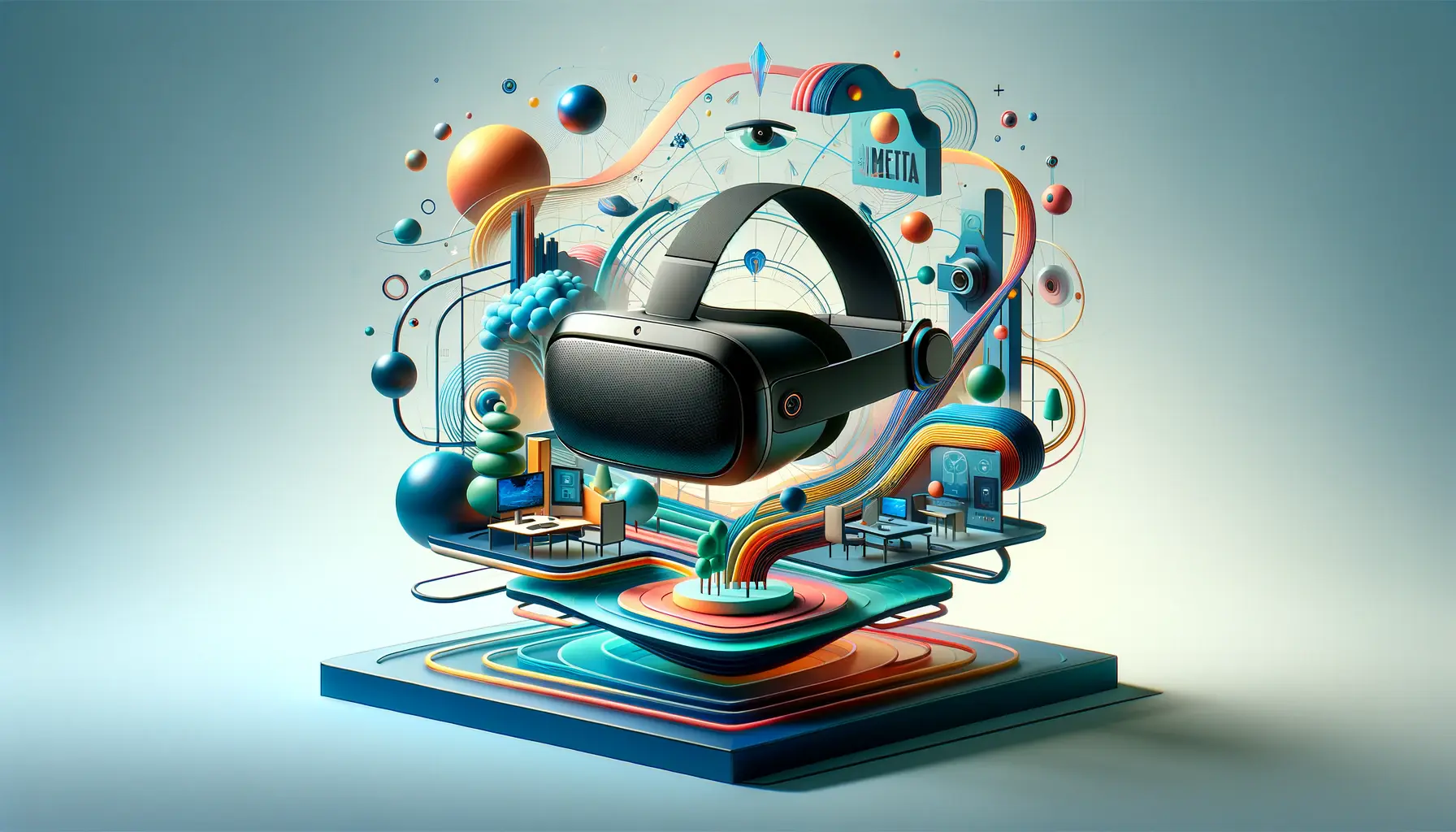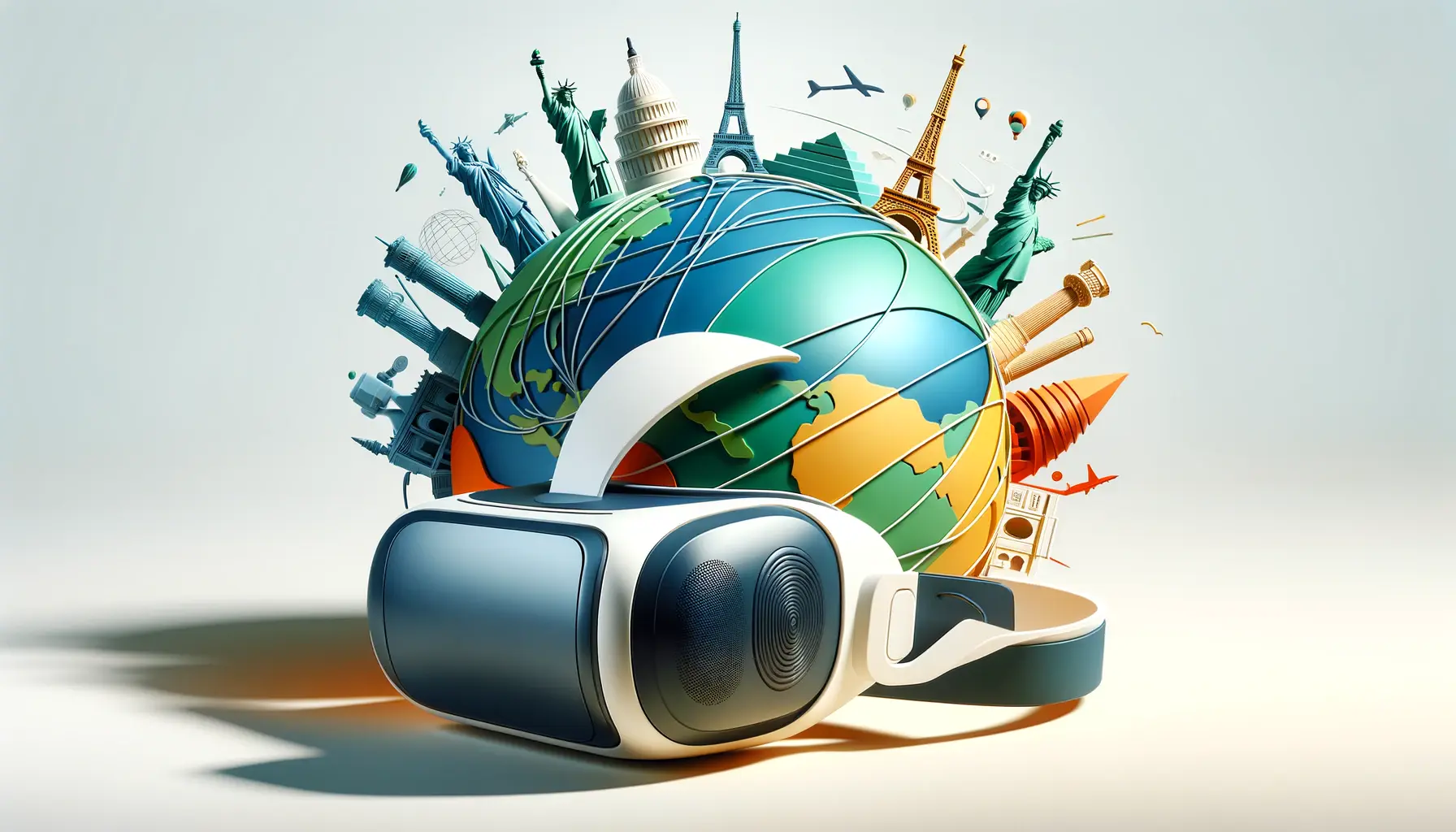The digital marketing landscape is continuously evolving, with new technologies emerging to change how brands interact with their audiences.
Among these innovations, virtual reality (VR) stands out as a transformative force, redefining the boundaries of content marketing.
Virtual reality, once a concept confined to science fiction, has now become an accessible tool for marketers, offering immersive experiences that engage consumers on a level previously unimaginable.
Virtual reality’s rise in the content marketing sphere is not just about novelty; it’s about creating a deeper connection with audiences.
By transporting users into entirely new worlds, VR allows brands to tell their stories in a more compelling and memorable way.
This technology’s unique ability to captivate and immerse users holds the potential to revolutionize content marketing strategies, making it an essential tool for brands looking to stand out in a crowded digital ecosystem.
- The Evolution of Virtual Reality in Marketing
- Strategies for Integrating VR into Content Marketing
- Challenges and Solutions in VR Content Marketing
- Key Technologies Behind VR Content Creation
- Future Trends in VR Content Marketing
- Best Practices for VR Content Marketing Success
- Incorporating VR into the Customer Journey
- Embracing the Future with Virtual Reality in Content Marketing
- FAQs on Virtual Reality Experiences in Content Marketing
The Evolution of Virtual Reality in Marketing
The Journey from Novelty to Necessity
Virtual reality’s journey in the marketing domain has transitioned from a novel gimmick to a necessary component of innovative marketing strategies.
Initially, VR was perceived as an expensive and complex technology, accessible only to brands with substantial budgets.
However, as VR technology has become more affordable and user-friendly, its adoption across various industries has skyrocketed.
This democratization of VR technology has opened new avenues for content marketers to explore immersive storytelling and interactive experiences.
Today, virtual reality is not just about gaming or entertainment; it’s a powerful marketing tool that offers unparalleled engagement opportunities.
Brands across sectors are leveraging VR to create immersive experiences that not only entertain but also educate and inspire their audiences.
From virtual tours and product demonstrations to interactive narratives, VR is enabling marketers to connect with their audiences in a more meaningful and impactful way.
Enhancing User Engagement with VR
One of the most significant advantages of virtual reality in content marketing is its ability to enhance user engagement.
By immersing users in a virtual world, VR captures their attention in a way that traditional media cannot.
This immersive experience fosters a deeper emotional connection with the content, leading to higher levels of engagement and retention.
Whether it’s exploring a virtual representation of a product or participating in a story, VR experiences are memorable and impactful, making them an invaluable tool for building brand awareness and loyalty.
Moreover, VR’s interactive nature encourages users to actively participate in the experience, rather than passively consuming content.
This active engagement not only increases the time spent with the brand but also enhances the user’s understanding and appreciation of the product or service being marketed.
As a result, virtual reality experiences can significantly boost conversion rates and drive sales, making VR a potent tool in a marketer’s arsenal.
Virtual reality is transforming content marketing by offering immersive and interactive experiences that enhance user engagement and foster a deeper connection with brands.
Strategies for Integrating VR into Content Marketing
Integrating virtual reality into content marketing requires a strategic approach that aligns with your brand’s overall marketing objectives.
The immersive nature of VR offers a unique opportunity to engage audiences, but it demands careful planning and execution to be effective.
Here are strategies to effectively incorporate VR into your content marketing efforts:
Identifying the Right Opportunities for VR
Not all content is suitable for virtual reality.
Identifying the right opportunities where VR can add value is crucial.
Consider using VR for:
- Product demonstrations that allow users to explore features in a 3D space.
- Virtual tours of facilities or locations, providing an immersive experience of places that are otherwise inaccessible to your audience.
- Interactive storytelling that engages users in your brand narrative in a compelling way.
Creating Immersive and Valuable Content
The content for VR should be immersive and provide value to the user.
Focus on creating experiences that are:
- Engaging: Design interactive elements that keep users active and involved.
- Educational: Use VR to teach something new or provide insights into your products or services.
- Entertaining: Incorporate fun elements to make the VR experience enjoyable and memorable.
Ensuring Accessibility and User-Friendliness
For VR content marketing to be effective, it must be accessible and user-friendly.
Consider the following:
- Compatibility with various VR headsets and platforms to reach a broader audience.
- Intuitive design and navigation to ensure a seamless user experience.
- Clear instructions and guidance for users who may be new to VR.
Leveraging Social Media and Online Platforms
Maximize the reach of your VR content by leveraging social media and online platforms.
Share:
- Teasers and previews of your VR content on platforms like YouTube, Facebook, and Instagram.
- Behind-the-scenes looks at the creation of your VR experiences to build anticipation.
- User-generated content and testimonials from those who have experienced your VR content.
Measuring Success and Gathering Feedback
Like any marketing effort, measuring the success of your VR content marketing is essential.
Use analytics tools to track:
- Engagement metrics such as time spent, interaction rates, and completion rates.
- User feedback through surveys and social media to gather insights and improve future VR content.
- Conversion rates and ROI to evaluate the effectiveness of your VR marketing efforts.
Incorporating VR into content marketing not only enhances user engagement but also sets your brand apart as an innovator in your industry.
Challenges and Solutions in VR Content Marketing
While virtual reality offers a plethora of opportunities for content marketing, it also presents unique challenges.
Understanding these challenges and identifying solutions is crucial for brands looking to leverage VR effectively.
One of the primary hurdles in VR content marketing is the cost and complexity of creating high-quality VR experiences.
The production of VR content requires specialized equipment and expertise, which can be expensive.
However, the solution lies in starting small and scaling up.
Brands can begin with simpler, less expensive VR projects to test the waters before committing to more complex and costly endeavors.
Additionally, leveraging existing VR platforms and tools can reduce development costs and complexity.
Overcoming Technical Limitations
Technical limitations, such as the need for high-end hardware by users and potential compatibility issues, can hinder the widespread adoption of VR content.
To address this, brands should focus on creating VR experiences that are accessible on lower-end devices and platforms.
This can be achieved by optimizing content for web-based VR platforms, which do not require users to have high-end VR headsets, thereby broadening the audience reach.
Enhancing User Experience
Ensuring a seamless and enjoyable user experience is essential for the success of VR content marketing.
This involves addressing common user experience issues such as motion sickness and navigation difficulties within the VR environment.
Solutions include designing VR experiences with user comfort in mind, such as minimizing rapid movements and providing clear, intuitive navigation controls.
Additionally, offering users the ability to customize their VR experience can enhance comfort and engagement.
Content Discoverability
Another challenge is ensuring that the target audience can easily discover VR content.
To improve discoverability, brands should integrate their VR content into their broader marketing strategy.
This includes promoting VR experiences through social media, email marketing, and other digital channels.
Employing SEO best practices for VR content and leveraging partnerships with VR platforms and influencers can also increase visibility.
Measuring Impact and ROI
Measuring the impact and ROI of VR content marketing efforts can be challenging due to the relatively new nature of the medium.
However, by setting clear objectives and utilizing VR analytics tools, brands can track engagement metrics, user behavior, and conversion rates.
These insights can inform future VR projects and help demonstrate the value of VR content marketing to stakeholders.
Despite the challenges, the potential benefits of VR content marketing—such as increased engagement, brand differentiation, and deeper customer connections—make it a worthwhile investment for forward-thinking brands.
Key Technologies Behind VR Content Creation
The creation of virtual reality content is underpinned by several key technologies that enable the immersive experiences we’ve come to associate with VR.
Understanding these technologies is crucial for marketers looking to delve into VR content creation.
At the core of VR content creation is the VR software development kit (SDK).
SDKs provide the tools and libraries necessary for developing VR applications.
Popular SDKs include Unity and Unreal Engine, which support a wide range of VR headsets and platforms.
These engines are powerful in creating realistic environments and interactive experiences, making them the backbone of VR content development.
3D Modeling and Animation Tools
Creating virtual environments and objects requires the use of 3D modeling and animation software.
Tools such as Blender, Maya, and 3ds Max enable designers to create detailed 3D models and animations that are then imported into VR development environments.
These models can range from simple objects to complex, animated characters, providing the visual elements that make up the VR world.
Audio Production for VR
Immersive audio is a critical component of VR that enhances the sense of presence in a virtual environment.
Spatial audio technology allows sound to be placed within a 3D space, simulating how we hear sounds in the real world.
Tools for creating spatial audio include Dolby Atmos and the Facebook Spatial Workstation, which enable sound designers to craft audio that moves and reacts to the user’s actions and orientation within the VR experience.
User Interaction and Control Systems
Interactivity is what sets VR apart from traditional media, and this is made possible through user interaction and control systems.
Motion tracking hardware, such as the Oculus Touch controllers or the HTC Vive trackers, allows users to interact naturally with the virtual environment.
Developers use SDKs to integrate these hardware inputs into their VR applications, enabling everything from picking up objects to complex gesture-based controls.
Optimization and Testing Tools
Ensuring VR content runs smoothly across different devices requires optimization and testing.
Tools like the Oculus Developer Hub and SteamVR Performance Test help developers optimize their content for various hardware specifications, ensuring a comfortable and accessible experience for all users.
Testing on multiple devices and platforms is essential to identify and fix performance issues, ensuring the VR experience is seamless and immersive.
The successful creation of VR content hinges on a combination of advanced software, 3D modeling, spatial audio, interactive controls, and rigorous testing to ensure the best possible user experience.
Future Trends in VR Content Marketing
The realm of virtual reality content marketing is rapidly evolving, with new trends emerging that promise to further transform how brands engage with their audiences.
Staying ahead of these trends is crucial for marketers aiming to leverage VR to its fullest potential.
Increased Personalization and Interactivity
As VR technology advances, we can expect to see a significant increase in the level of personalization and interactivity within VR experiences.
Future VR content marketing will likely include:
- Dynamic content that adapts to individual user preferences and behaviors.
- Interactive narratives that allow users to choose their own paths, creating unique story experiences for each viewer.
- Real-time data integration, enabling personalized product recommendations and customized environments within the VR experience.
Integration with Artificial Intelligence
Artificial intelligence (AI) and machine learning are set to play a pivotal role in the evolution of VR content marketing.
This integration will enable:
- Smarter content that learns from user interactions, improving engagement and effectiveness over time.
- Automated content creation tools that can generate complex VR environments and scenarios, reducing production time and costs.
- Enhanced analytics capabilities, providing deeper insights into user behavior and preferences within VR experiences.
Expansion into New Industries
While gaming and entertainment currently dominate the VR landscape, the future will see VR content marketing expand into new industries, including:
- Education and training, where VR can provide immersive learning experiences.
- Healthcare, offering virtual therapy sessions and medical training simulations.
- Real estate, enabling virtual property tours and architectural visualizations.
- Retail, with virtual stores and try-before-you-buy experiences for products.
Advancements in Hardware and Accessibility
The future of VR content marketing will also be shaped by advancements in VR hardware and increased accessibility.
Expectations include:
- Lighter, wireless headsets with longer battery life, making VR more comfortable and convenient for extended use.
- Lower-cost VR solutions, making the technology accessible to a broader audience.
- Improved resolution and field of view, enhancing the realism and immersion of VR experiences.
Greater Emphasis on Social VR Experiences
Social VR experiences, where users can interact with each other within a virtual space, are expected to become a significant trend in VR content marketing.
These experiences offer:
- Opportunities for brands to create virtual communities around their products or services.
- New avenues for event marketing, including virtual conferences, concerts, and brand activations.
- Enhanced user engagement through shared experiences and social interactions within the VR environment.
The future of VR content marketing is rich with opportunities for innovation, offering brands new ways to connect with their audiences through personalized, interactive, and socially engaging experiences.
Best Practices for VR Content Marketing Success
To maximize the impact of virtual reality in content marketing, brands must adhere to a set of best practices.
These guidelines ensure that VR campaigns are not only technologically impressive but also strategically effective in engaging audiences and achieving marketing objectives.
Understanding your audience’s needs and preferences is paramount.
This involves:
- Conducting thorough market research to identify the types of VR experiences your target audience is most likely to engage with.
- Segmenting your audience to tailor VR experiences that cater to different interests and behaviors.
Focus on Storytelling and Emotional Connection
At the heart of effective VR content marketing lies compelling storytelling and the ability to forge an emotional connection with the audience.
To achieve this, brands should:
- Develop narratives that resonate with viewers, using immersive VR capabilities to enhance the storytelling impact.
- Utilize VR to evoke emotions and create memorable experiences that strengthen brand affinity.
Ensure High-Quality Production
The quality of VR content can significantly affect user experience and perception of the brand.
High-quality production involves:
- Investing in professional VR content creation tools and expertise to ensure immersive and visually appealing experiences.
- Paying attention to detail in the VR environment, including visuals, audio, and interactivity, to create a polished and engaging experience.
Integrate VR with Other Marketing Channels
VR should not exist in isolation but rather be integrated with other marketing channels for a cohesive campaign.
Integration strategies include:
- Promoting VR experiences through social media, email marketing, and your brand’s website to drive awareness and participation.
- Using VR as part of a larger campaign narrative, complementing other content formats and marketing activities.
Measure and Analyze Performance
Like any marketing initiative, the success of VR content marketing should be measured and analyzed.
This requires:
- Implementing VR analytics to track user engagement, behavior, and conversion metrics within the VR experience.
- Using insights from data analysis to refine and optimize future VR content marketing strategies.
Stay Updated with VR Trends and Technologies
The VR landscape is constantly evolving, with new trends and technologies emerging regularly.
Staying updated entails:
- Keeping abreast of the latest VR developments and considering how they can be applied to enhance your content marketing efforts.
- Experimenting with new VR features and capabilities to keep your content fresh and engaging.
By following these best practices, brands can effectively leverage virtual reality to create immersive, engaging, and memorable content marketing campaigns that resonate with their audiences and drive marketing success.
Incorporating VR into the Customer Journey
Integrating virtual reality into the customer journey enhances the overall experience, providing touchpoints that engage, educate, and convert potential customers in unique and memorable ways.
A strategic approach to incorporating VR can significantly impact the effectiveness of marketing campaigns and customer satisfaction.
To seamlessly integrate VR into the customer journey, consider the following stages:
Awareness Stage
At the awareness stage, potential customers are just beginning to recognize their needs or problems.
VR can be used to:
- Introduce your brand and products in an engaging way, setting you apart from competitors.
- Provide immersive experiences that highlight the issues your products or services solve, making a lasting impression on the audience.
Consideration Stage
During the consideration stage, customers evaluate different solutions to their problems.
VR can:
- Offer virtual product demonstrations or tours, allowing customers to explore features and benefits in depth.
- Simulate real-life usage of products or services, helping customers understand their value and applicability to their needs.
Decision Stage
At the decision stage, customers are ready to make a purchase.
VR can facilitate this process by:
- Providing immersive experiences that reinforce the product’s value and encourage the final decision.
- Offering virtual consultations or personalized recommendations, enhancing customer confidence in their choice.
Retention Stage
After the purchase, VR can be used to ensure customer satisfaction and loyalty.
This includes:
- Creating VR-based after-sales support and tutorials, improving the customer experience with the product.
- Developing exclusive VR content for existing customers, such as behind-the-scenes tours or upcoming product previews, to foster brand loyalty.
Advocacy Stage
Happy customers can become brand advocates.
VR enhances this transition by:
- Encouraging customers to share their VR experiences on social media, increasing brand visibility.
- Offering referral incentives through VR experiences, motivating customers to spread the word about your brand.
By thoughtfully integrating VR into each stage of the customer journey, brands can create a cohesive and immersive experience that not only attracts and retains customers but also turns them into advocates.
This strategic use of VR enriches the customer journey, making it more engaging and memorable, ultimately driving brand loyalty and growth.
Virtual reality offers a unique opportunity to enhance the customer journey at every stage, providing immersive experiences that engage, educate, and convert potential customers in ways traditional marketing cannot.
Embracing the Future with Virtual Reality in Content Marketing
The integration of virtual reality into content marketing represents a pivotal shift in how brands connect with their audiences.
As we’ve explored, VR offers unparalleled opportunities for engagement, storytelling, and creating immersive experiences that traditional digital marketing cannot match.
The evolution of VR from a niche technology to a mainstream marketing tool underscores its potential to revolutionize the industry.
The Transformative Impact of VR
Virtual reality in content marketing is not just about offering novel experiences; it’s about forging deeper connections with consumers.
By enabling audiences to experience products and services in a fully immersive environment, VR has the power to enhance understanding, retention, and emotional engagement.
This transformative impact extends across various stages of the customer journey, from awareness to advocacy, providing a comprehensive toolkit for marketers aiming to stand out in a crowded digital landscape.
Strategies for Success
Success in VR content marketing requires more than just technological investment; it demands a strategic approach that aligns with broader marketing goals.
Key strategies include focusing on storytelling, ensuring high-quality production, integrating VR with other marketing channels, and continuously measuring and optimizing performance.
Moreover, staying abreast of the latest trends and technological advancements is crucial for leveraging VR to its full potential.
Challenges and Opportunities Ahead
Despite its promise, virtual reality in content marketing is not without challenges.
Technical limitations, high production costs, and the need for specialized skills are significant hurdles.
However, these challenges also present opportunities for innovation and creativity.
As technology advances and becomes more accessible, we can expect to see VR content marketing evolve, offering even more sophisticated and engaging experiences for users.
Conclusion
As we look to the future, it’s clear that virtual reality will play an increasingly important role in content marketing.
Its ability to create immersive, interactive, and highly personalized experiences offers a new dimension of engagement that can significantly enhance brand perception and customer loyalty.
For marketers willing to embrace this technology, VR presents an exciting frontier with the potential to transform not only how we market products and services but also how we connect with consumers on a fundamental level.
The journey into virtual reality in content marketing is just beginning, and the possibilities are as limitless as the virtual worlds we can create.
Want your website to top Google search rankings? Leave the SEO to our professional agency!
FAQs on Virtual Reality Experiences in Content Marketing
Explore commonly asked questions about integrating virtual reality into content marketing strategies.
Virtual reality in content marketing refers to using immersive VR technology to create engaging and interactive experiences for audiences, enhancing brand storytelling and engagement.
VR offers unparalleled engagement by immersing users in a brand’s narrative, providing memorable experiences that enhance understanding, retention, and emotional connection.
VR captivates users with immersive experiences, increasing interaction and time spent with content, leading to higher engagement levels and brand loyalty.
Challenges include high production costs, technical complexities, and the need for specialized equipment, but these can be mitigated with strategic planning and scalable projects.
Success is measured through engagement metrics, user behavior analysis, and conversion rates, utilizing VR analytics tools to track and optimize performance.
Yes, VR content should be integrated with other marketing channels, such as social media and email, to enhance campaign reach and effectiveness.
Industries like real estate, retail, education, and healthcare benefit significantly from VR by offering immersive product demos, virtual tours, and educational experiences.
The future includes increased personalization, integration with AI, expansion into new industries, advancements in hardware, and a greater emphasis on social VR experiences.














